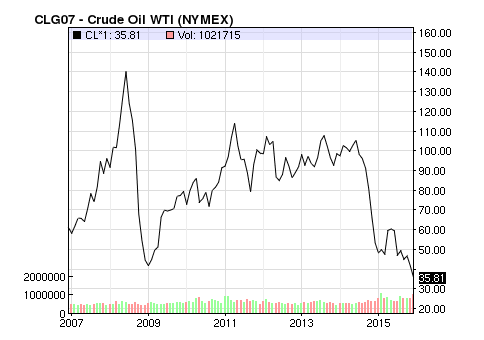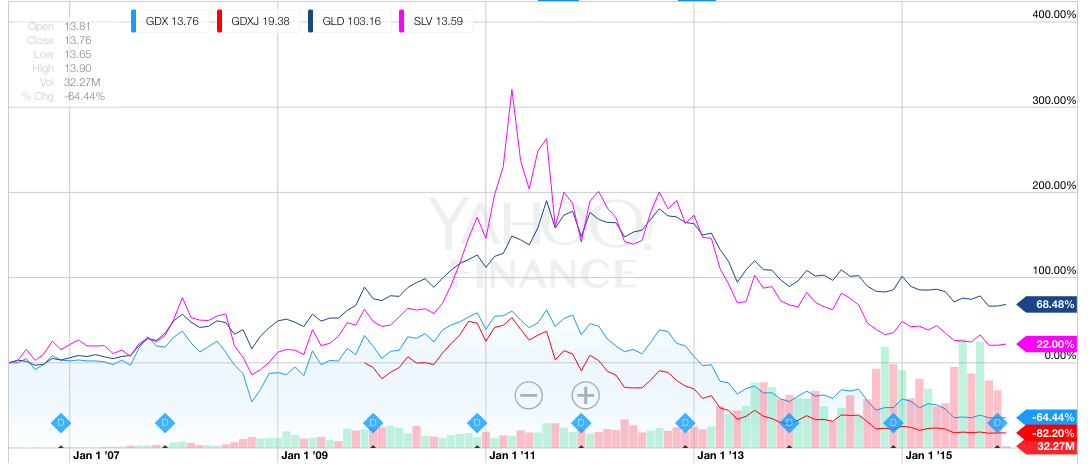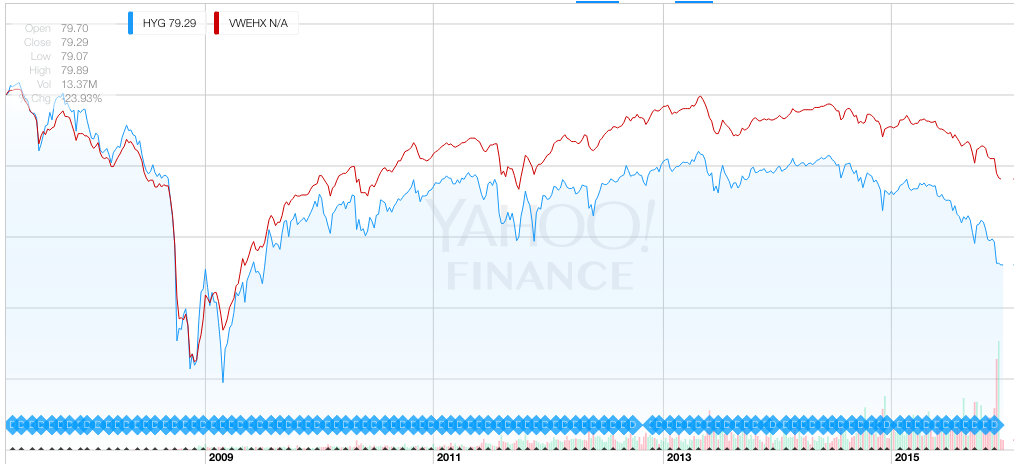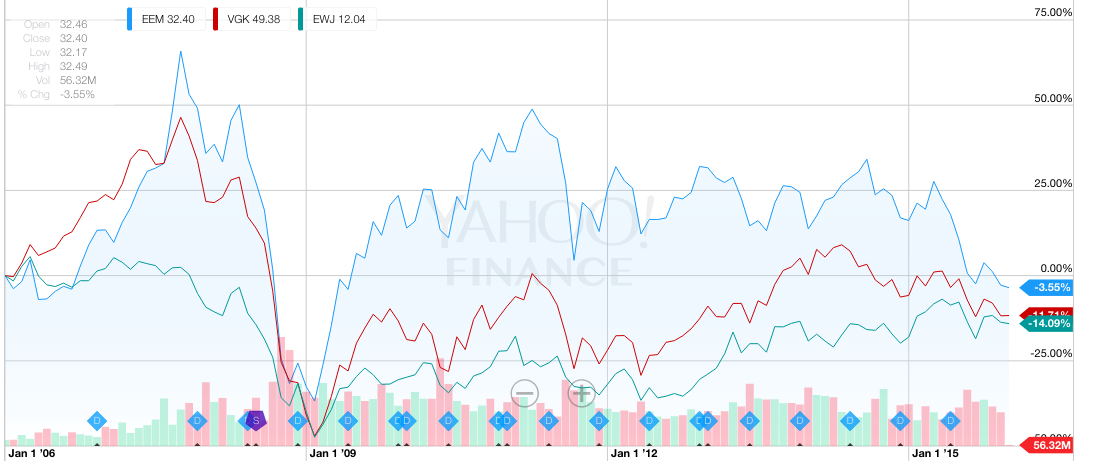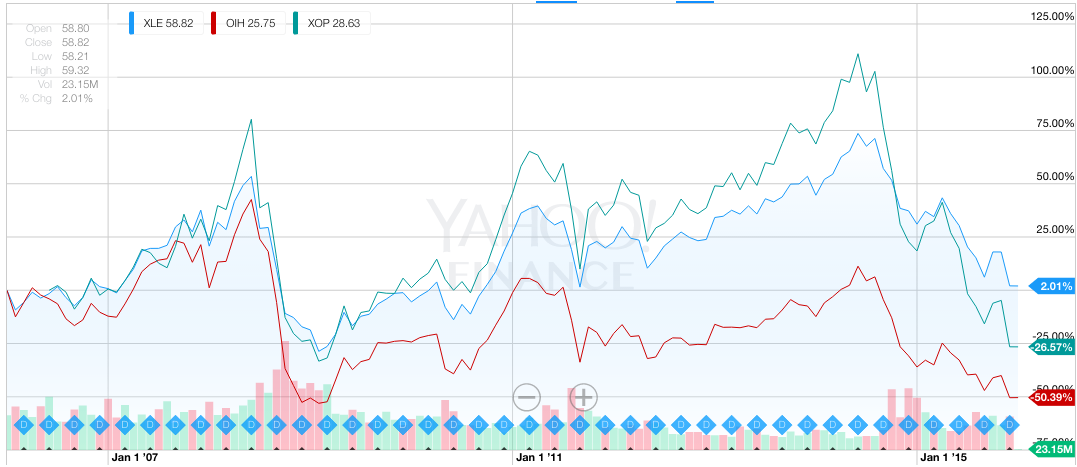Holiday Greetings
We wish everyone have a wonderful holiday. May the force be with you in the coming year!
Due to upcoming holidays, we will not have a newsletter next Monday and will resume the publication on January 4th, 2016.
Distressed Assets
In our last year’s newsletter December 15, 2014: Beaten Down Assets., we stated the three reasons why one should look at asset valuation with respect to one’s investment portfolios:
- Valuation helps to understand the general market conditions and thus re-enforce one’s risk profile or risk tolerance.
- Similarly, valuation helps to set one’s return expectation.
- Valuation helps us to find good possible investment candidates.
We believe it is a good practice to periodically look at the distressed assets. However how negative the ‘distressed’ sounds, it actually presents some potential opportunities. In fact, when an asset is really in a distressed state, it’s actually less risky and becomes a ‘good’ asset for purchase.
It turns out that this year, we are seeing more assets are joining to the group. What’s more, whatever beaten down last year are still languishing or getting even worse.
Commodities: Oil, Gold, Silver and Mining Stocks
Perhaps the most talked about asset this year is the crude oil price: it continued to descend from its 50’s level last year, now sitting in the 30’s level:
Not only the oil price is now lower than the most recent low in 2009, it hasn’t shown any sign of slowing down either. The oil shock reveals how an important commodity can be inter played with geopolitical situation. Its distress does not bode well with the global economy and political stability.
Gold, silver and their mining stocks continue to decline this year, now lower than their 2008-2009 lows:
Year to date:
| Fund | YTD Return** |
1Yr AR | 3Yr AR | 5Yr AR | 10Yr AR |
|---|---|---|---|---|---|
| GLD (SPDR Gold Shares) | -9.2% | -10.1% | -13.9% | -5.1% | 7.5% |
| SLV (iShares Silver Trust) | -10.9% | -12.0% | -24.1% | -14.0% | |
| GDX (Market Vectors Gold Miners ETF) | -25.8% | -26.8% | -32.6% | -25.2% | |
| GDXJ (Market Vectors® Junior Gold Miners ETF) | -19.3% | -21.5% | -37.4% | -32.6% |
Similarly, the general commodities and their segments have had more than 20% loss this year so far:
| Fund | YTD Return** |
1Yr AR | 3Yr AR | 5Yr AR |
|---|---|---|---|---|
| DBC (PowerShares DB Commodity Tracking ETF) | -28.1% | -29.9% | -21.7% | -12.9% |
| DBA (PowerShares DB Agriculture ETF) | -18.0% | -19.9% | -10.5% | -8.1% |
| DBE (PowerShares DB Energy ETF) | -38.0% | -40.8% | -26.9% | -16.0% |
| DBB (PowerShares DB Base Metals ETF) | -27.0% | -27.6% | -15.6% | -12.8% |
In a word, what went down in 2014 have continued to go down. A gigantic deflation in natural resources.
Just as Oaktree’s Howard Marks said (see this interview): the problem with crude oil is that no one knows its intrinsic value. At the moment, we see no sign of recovery in the short term. However, it is definitely an asset class worth continuing watch.
High Yield Bonds
After our last week’s review on high yield bonds December 14, 2015: High Yield Bonds And Their Correlation With Stocks, even after the Federal Reserve faith showing or confidence boosting rate raise, high yield bonds continue to be dumped:
It is noteworthy that HYG is now approaching the low in 2008-2009: it is at the lowest level since the 2008-2009 crisis for sure. The price of HYG is now at -0.24% discount of its Net Asset Value (NAV), due to some illiquid bond pricing issue. However, it is still no where close to the double digit discount it made during 2008-2009.
We wouldn’t call high yield bonds are in a distressed state right now. But the energy debts are close or even worse than in 2008-2009.
Emerging Market Stocks, Europe & Japan
Emerging market stocks continued its weakness in 2014, down 16% year to date:
| Fund | YTD Return** |
1Yr AR | 3Yr AR | 5Yr AR | 10Yr AR |
|---|---|---|---|---|---|
| EEM (iShares MSCI Emerging Markets) | -16.3% | -14.7% | -7.6% | -4.9% | 3.0% |
| VGK (Vanguard FTSE Europe ETF) | -3.4% | -5.1% | 3.9% | 4.1% | 3.3% |
| EWJ (iShares MSCI Japan) | 8.2% | 6.2% | 9.4% | 4.0% | 0.4% |
Emerging market stocks are now the lowest since 2009, but still not reaching the low in 2009. Notice that even though European stocks are weak in terms of US dollar, they have done reasonably well in their local currency, Euro. Similarly Japanese stocks have been propped up by the government stimulus. However, both of them are seriously impacted by US dollar strength. However, in emerging markets, many stocks are down even in their own local currencies, indicating a dire situation (think about Brazil, China, Russia).
US Stocks: Oil & Gas Stocks
Even though US stocks have encountered some weakness, they are in general still the strongest among all stock major assets. However, energy stocks, especially oil & gas stocks are now approaching the 2008-2009 level:
Summary
As 2015 is closing out, it is amazing to see not only the beaten down stocks in 2014 continue to be weakened, new assets including high yield bonds and oil & gas stocks are joining the group. However, even these assets are becoming more and more attractive right now, we don’t believe the carnage stops right now. As to whether one should be a bargain hunter or not right now, we believe it is important to adhere to your investment plan and act accordingly. Catching a falling knife can be painful.
Finally, we quote the following from our last year’s newsletter. They are still applicable even after the volatile year!
Subjectively, other than commodities, all other assets are far from a distressed valuation level. With US stocks are still at an elevated valuation level, markets are again far from a panic on sale state. Furthermore, a momentum based tactical strategy will only buy an asset when it again exhibits an upward trend, a more risk averse way to invest in undervalued assets.
Market Overview
Now that the (uncertain) Fed rate hike is out of way, it is alarming that stocks and high yield bonds faded its short lived rebound and now they are back to the down trend. At the moment, not only long term Treasury bonds preserve their strength, REIT stocks are also withholding the downturn relatively well. This indicates that investors are worried about the long term aspect of the economy (long term bonds), but they are still holding a hope that the Fed will be extremely accommodative in terms of financing (REITs).
For more detailed asset trend scores, please refer to 360° Market Overview.
We would like to remind our readers that markets are more precarious now than other times in the last 5 years. It is a good time and imperative to adjust to a risk level you are comfortable with right now. However, recognizing our deficiency to predict the markets, we will stay on course.
We again copy our position statements (from previous newsletters):
Our position has not changed: We still maintain our cautious attitude to the recent stock market strength. Again, we have not seen any meaningful or substantial structural change in the U.S., European and emerging market economies. However, we will let markets sort this out and will try to take advantage over its irrational behavior if it is possible.
We again would like to stress for any new investor and new money, the best way to step into this kind of markets is through dollar cost average (DCA), i.e. invest and/or follow a model portfolio in several phases (such as 2 or 3 months) instead of the whole sum at one shot.
Latest Articles
- December 14, 2015: High Yield Bonds And Their Correlation With Stocks
- December 7, 2015: Diversification And Global Allocation
- November 30, 2015: Investors and Speculators Combined
- November 23, 2015: Active Stock Fund Performance Consistency
- November 16, 2015: Permanent, Risk Parity And Alternative Portfolios Review
- November 9, 2015: Broad Base Core Mutual Fund Review
- November 2, 2015: Broad Base Index Core ETFs Review
- October 26, 2015: Total Return Bond Fund Review
- October 19, 2015: Advanced Portfolio Review
- October 12, 2015: What About Commodities?
- October 5, 2015: Core Satellite Portfolios In A 401k Account
- September 28, 2015: Risk Managed Strategic Asset Allocation Portfolios Revisited
- September 21, 2015: Quest For The Best Investment Strategy
- September 14, 2015: Core Satellite Portfolios In Market Turmoil
- September 7, 2015: Market Rout Creates An Opportunity to Reposition Your Portfolios
- August 31, 2015: Review of Asset Allocation Funds and Portfolios
- August 24, 2015: Market Rout And Your Portfolios
- August 17, 2015: ETF or Mutual Fund Based Portfolios
- August 10, 2015: Updated Newsletter Collection
- August 3, 2015: Slippery Asset Trends
- July 27, 2015: Performance Dispersion Among Momentum Based Portfolios
- July 20, 2015: Global Balanced Portfolio Benchmarks
- July 13, 2015: Pain in Tactical Portfolios
- July 6, 2015: Fixed Income Total Return Bond Funds In Strategic Asset Allocation Portfolios
- June 29, 2015: Core ETF Commission Free Portfolios
- June 22, 2015: Secular Asset Trends
- June 15, 2015: Giving Up Bonds?
- June 1, 2015: Summer Blues?
- May 26, 2015: Cash, Bonds and Stocks In A Rising Rate Environment
- May 18, 2015: Portfolio Update
- May 11, 2015: Pain in Fixed Income?
- May 4, 2015: The Balanced Stock and Long Term Treasury Bond Portfolios
- April 27, 2015: Long Term Treasury Bond Behavior
- April 20, 2015: 529 College Savings Plan Rebalance Policy Change
- April 13, 2015: Total Return Bond Funds As Smart Cash
- April 6, 2015: The Low Return Environment
- March 30, 2015: Brokerage Specific Core Mutual Fund Portfolios 2
- March 23, 2015: Investment Arithmetic for Long Term Investments
- March 16, 2015: Brokerage Specific Core Mutual Fund Portfolios
- March 9, 2015: Newsletter Collection Update
- March 2, 2015: Total Return Bond ETFs
- February 23, 2015: Why Is Global Tactical Asset Allocation Not Popular?
- February 16, 2015: Where Are Permanent Portfolios Going?
- February 9, 2015: How Have Asset Allocation Funds Done?
- February 2, 2015: Risk Management Everywhere
- January 26, 2015: Composite Portfolios Review
- January 19, 2015: Fixed Income Investing Review
- January 12, 2015: How Does Trend Following Tactical Asset Allocation Strategy Deliver Returns
- January 5, 2015: When Forecast Fails
- December 22, 2014: Long Term Asset Returns: How Long Is Long?
- December 15, 2014: Beaten Down Assets
- December 8, 2014: Implementing Core Asset Portfolios In a Brokerage
- December 1, 2014: Two Key Issues of Investment Strategies
- November 24, 2014: Holiday Readings
- November 17, 2014: Retirement Spending Portfolios Update
- November 10, 2014: Fixed Income Or Cash
- November 3, 2014: Asset Trend Review
- October 27, 2014: Investment Loss, Mistakes And Market Cycles
- October 20, 2014: Strategic Portfolios With Managed Volatility
- October 13, 2014: Embrace Volatility
- October 6, 2014: Tips For 401k Open Enrollment
- September 29, 2014: What Can We Learn From Bill Gross’ Departure From PIMCO?
- September 22, 2014: Why Total Return Bond Funds?
- September 15, 2014: Equity And Total Return Bond Fund Composite Portfolios
- September 8, 2014: Momentum Based Portfolios Review
- September 1, 2014: Risk & Diversification: Mint.com Interview
- August 25, 2014: Remember Risk
- August 18, 2014: Consistency, The Most Important Edge In Investing: Tactical Case
- August 11, 2014: What To Do In Overvalued Stock Markets
- August 4, 2014: Is This The Peak Or Correction?
- July 28, 2014: Stock Musings
- July 21, 2014: Permanent Portfolios & Four Pillar Foundation Based Framework
- July 14, 2014: Composite Portfolios Review
- July 7, 2014: Portfolio Behavior During Market Corrections
- June 30, 2014: Half Year Brokerage ETF and Mutual Fund Portfolios Review
- June 23, 2014: Newsletter Collection Update
- June 16, 2014: There Are Always Lottery Winners
- June 9, 2014: The Arithmetic of Investment Mistakes
- June 2, 2014: Tips On Portfolio Rebalance
- May 26, 2014: In Praise Of Low Cost Core Asset Class Based Portfolios
- May 19, 2014: Consistency, The Most Important Edge In Investing: Strategic Case
- May 12, 2014: How To Handle An Elevated Overvalued Market
- May 5, 2014: Asset Allocation Funds Review
- April 28, 2014: Now The Economy Backs To The ‘Old Normal’, Should Our Investments Too?
- April 21, 2014: Total Return Bond Investing In The Current Market Environment
Enjoy Newsletter
How can we improve this newsletter? Please take our survey
–Thanks to those who have already contributed — we appreciate it.

